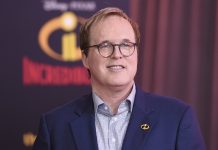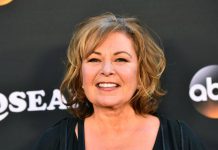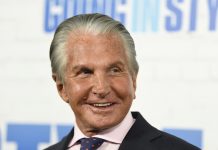LONDON (AP) — Sir Roger Moore saw more to life than a well-mixed martini.
“I felt small, insignificant and rather ashamed that I had traveled so much making films and ignored what was going on around me,” he would say years after starring in seven James Bond movies and upon accepting a role that his friend Audrey Hepburn inspired him to take on, goodwill ambassador for UNICEF.
Moore, who died Tuesday at age 89, didn’t seem to take Bond that seriously even while playing him. Burdened with following Sean Connery as Agent 007, Moore kept it light, using a wry, amused tone and perpetually arched eyebrow as if he had landed on the set by accident. Connery embodied for millions the role of Bond as the suave drinker, womanizer and disposer of evil. Moore didn’t so much inhabit the character as look upon him with disbelief.
“To me, the Bond situations are so ridiculous, so outrageous,” he once said. “I mean, this man is supposed to be a spy and yet, everybody knows he’s a spy. Every bartender in the world offers him martinis that are shaken, not stirred. What kind of serious spy is recognized everywhere he goes? It’s outrageous. So you have to treat the humor outrageously as well.”
The handsome, dark-haired actor had long, full lives before and after his debut as Bond, in 1973.
He was remembered warmly by fans of the popular U.S. 1950s-60s TV series “Maverick” as Beauregarde Maverick, the English cousin of the Wild West’s Maverick brothers, Bret and Bart. He also starred in the 1959 U.S. series “The Alaskans.” In England, he had a long-running TV hit with “The Saint,” playing Simon Templar, the enigmatic action hero who helps put wealthy crooks in jail while absconding with their fortunes. By the time the series, which also aired in the United States, ended in 1969, his partnership with its producers had made him a wealthy man.
He succeeded even as critics scorned. His performance opposite Lana Turner in the 1956 movie “Diane” was likened by Time magazine to “a lump of English roast beef.” In the 1970s, New York Times reviewer Vincent Canby dismissed Moore’s acting abilities as having “reduced all human emotions to a series of variations on one gesture, the raising of the right eyebrow.”
He was more inspired when helping others. He became the UNICEF ambassador in 1991 and five years later attended the World Congress Against Commercial Sexual Exploitation of Children, and disclosed that he too had been a victim.
“I was molested when I was a child — not seriously — but I didn’t tell my mother until I was 16, because I felt that it was something to be ashamed of,” he told The Associated Press at the time.
He gave no details, but said it was important to encourage young victims not to feel guilty.
“They’re being exploited. We have to tell them that,” Moore said.
In 2003, he was knighted by Queen Elizabeth II, not for his acting, but for his humanitarian work. Moore received the Dag Hammarskjold Inspiration Award for his contributions to UNICEF and was named a commander in France’s National Order of Arts and Letters in 2008, an award he said was worth “more than an Oscar.” In a statement Tuesday, UNICEF executive director Anthony Lake praised Moore as one of the “great champions for children.”
“In his most famous roles as an actor, Sir Roger was the epitome of cool sophistication; but in his work as a UNICEF Goodwill Ambassador, he was a passionate – and highly persuasive — advocate for children,” Lake wrote. “He once said that it was up to all of us to give children a more peaceful future. Together with Lady Kristina, he worked very hard to do so.”
Born in London, the only child of a policeman, Moore had studied painting before enrolling in the Royal Academy of Dramatic Art. He played a few small roles in theater and films before his mandatory army duty, then moved to Hollywood in the 1950s. He appeared opposite Elizabeth Taylor in 1954′s “The Last Time I Saw Paris” and with Eleanor Parker in “Interrupted Melody” the following year.
In 1970, he became managing director for European production for Faberge’s Brut Productions. With the company, he co-starred with Tony Curtis in “The Persuaders!” for British television and helped produce “A Touch of Class,” which won a best-actress Oscar for Glenda Jackson.
Three years later, he made his first Bond film, “Live and Let Die.” He would make six more, “The Man With the Golden Gun,” ″The Spy Who Loved Me,” ″Octopussy,” ″Moonraker,” ″For Your Eyes Only and “A View to a Kill” over the next 12 years. And while the Bond of the Ian Fleming novels that the films were based on was generally described as being in his 30s, Moore would stay with the role until he was 57.
He continued to work regularly in films after handing over Bond to Timothy Dalton, but never with the same success. His post-Bond films included such forgettable efforts as “The Quest” with Jean-Claude Van Damme and “Spice World” with the Spice Girls.
Moore was divorced three times, from skater Doorn Van Steyn in 1953, English singer Dorothy Squires in 1969 and Italian actress Luisa Mattioli, the mother of his children Deborah, Geoffrey and Christian, in 2000.
He married Swedish socialite Kristina Tholstrup in 2002.














